Bowmanville POW Camp: Camp 30 is One of Ontario’s Creepiest Places

You may be surprised to hear that there were over 25 prisoners of war camps in Canada during the Second World War. With 13 in Ontario alone, a short hour road trip from Toronto lies the remnants of Camp 30 – the Bowmanville POW Camp. It’s hands down one of the creepiest places in Ontario I’ve ever been to… and it didn’t help I visited days before Halloween.
Camp 30 wasn’t always a POW camp. What started from humble beginnings became a dark entity with the eruption of World War II. The future of Camp 30 was uncertain at one time due to the rampant vandalism and disrepair of the area. However, it received a National Historic Site of Canada designation in September of 2013 which has changed its fate.
Let’s dive into the history of the Bowmanville POW Camp, its present state and plans for the future.
Looking for More Haunted Places in Ontario?
Don’t Miss These 15 Haunted Destinations in Hamilton
See a Darker Side of Niagara with These 10+ Haunted Spots
Why Niagara Falls’ Screaming Tunnel Got Its Name
TABLE OF CONTENTS
History of the Bowmanville POW Camp
In the early 1920s, the land Camp 30 sits on was owned by John H. H. Jury, a horticulturist and pharmacist. Known as the Darch Farm, he donated its 300 acres to the provincial government in 1922 to build the Bowmanville Boys Training School. This was after he witnessed a speech by Alex Edmison about juvenile delinquency and wanted the government to create a school based on the theories brought forth by Edmison.
Influenced by the architectural style of Frank Lloyd Wright, the campus called on many of his iconic elements. The buildings use natural materials, geometric ornamentation and an emphasis on the horizontal shape reminiscent of the prairie landscape.
Completed in 1927, this boarding school implemented non-institutional modes of education to reform delinquent boys by providing them with a mental, moral, physical and vocational education and training. Each student had their academic level assessed upon entering and the programs/structure it offered placed it ahead of that time’s youth reform movement. The curriculum allowed students to earn credits to work towards their secondary school diploma. The school was open for 14 years until the government forced them to vacate so it could be converted into a prisoner of war camp.
Canadian officials had barely half a year to convert the property. While the school was designed to contain lots of people, many tasks had to be completed before it could be used as a POW camp. Wire fences and guard towers were built along with gates and barracks for the Canadian guards. Completed in October of 1941, this is when the first POWs started to arrive on Canadian soil.
During World War II, it became an internment camp for officers and ranking officials of the German Armed Forces. Captured by the Allied Forces, they were sent from the United Kingdom to Canada as the possibility of invasion by the Nazis could mean their release. Enemy combatants were held until 1945 and sent back to Europe with the end of World War II.
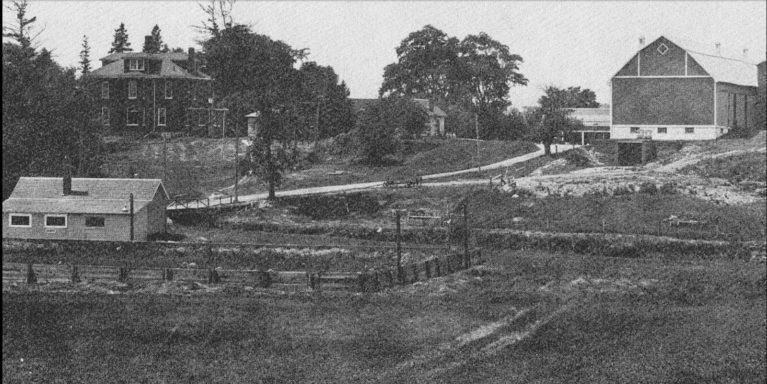
Old photo of the Darch Farm. Photo taken from the Clarington website.
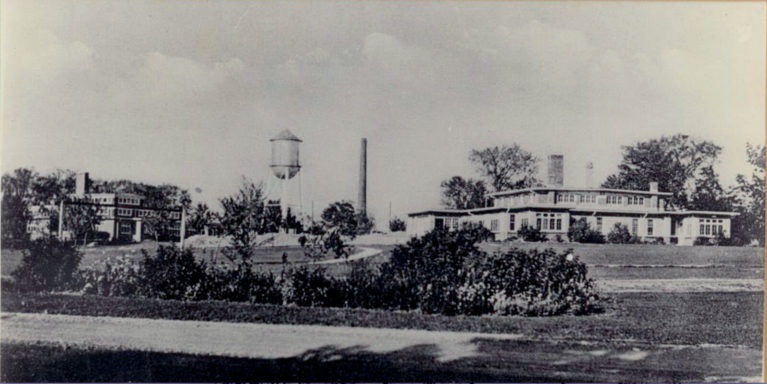
Old photo of the Bowmanville Boys School. Photo taken from the Clarington website.
Life at Camp 30 During WWII
As far as POW Camps go, life at Camp 30 was pretty amicable. Since it was previously a boys school, it allowed for a number of amenities other camps didn’t have like an indoor pool, athletic complex, soccer and football fields. The POWs were said to have played football and hockey during the winter months. As they were still being paid, they purchased items from the canteen like cigarettes, cigars, tobacco, pipes, pens, pencils, ink, daily hygiene items like toothpaste and mouthwash, clothing, food and more. They regularly sent and received mail from their families as well. The list goes on.
An added benefit was that since the prisoners worked the Darch Farm, their meals were far above other POW camp standards. Meals often included butter, coffee, jam and other more luxurious items. Not only that, but the meals were hearty as they consisted of items like roast beef with carrots, potatoes and even gravy. Needless to say, there were few complaints about the camp’s conditions.
Life at the Bowmanville Prisoner of War Camp was also civil due to the concept of Ehrenwort. Meaning “word of honour” in German, prisoners were allowed to leave the camp if they gave their word that they would not attempt to escape. As they always returned, they were permitted to swim at the lake close by during the summer months and even go cross-country skiing in the winter. This is quite unheard of in regards to POW camps, but it worked for Camp 30 and meant both the guards and prisoners were overall fairly content considering the circumstances.
This doesn’t mean that Camp 30 always ran smoothly. One of the most notable events was the Battle of Bowmanville, caused by Hitler’s order to have Allied POWs shackled. Britain got wind of this and ordered Canadians to do the same at Camp 30 and to not remove them until the Allied’s shackles were removed. When Canadian guards asked for 100 volunteers, they obviously had no takers and were instead met with great resistance. The German POWs barricaded themselves in the cafeteria and fought with anything they could find from bats to bottles and even hockey sticks. The Battle of Bowmanville lasted two days before Canadians gained control again and 125 of the prisoners were sent to different prisoner of war camps.
Despite the concept of Ehrenwort, there were still plenty of escape attempts however none were successful. The most elaborate attempts were when the prisoners tried to build tunnels under the camp. Most notable is the tunnel started in Victoria Hall or House IV as it included lighting, ventilation and supports. Though the most famous attempt would be Operation Kiebitz, which you may recognize. This failed escape plan tried to break out four skilled German U-Boat officers but was thwarted by the Royal Canadian Navy’s Operation Maisonette.
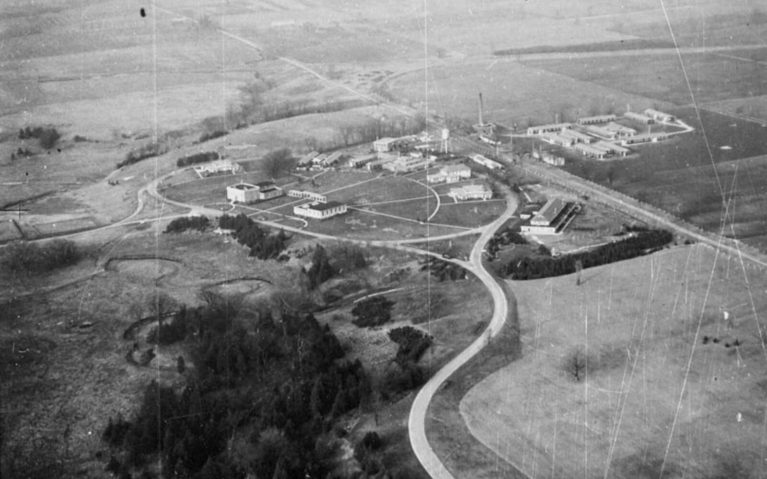
Aerial view of the Bowmanville POW Camp. Taken from the Clarington website.
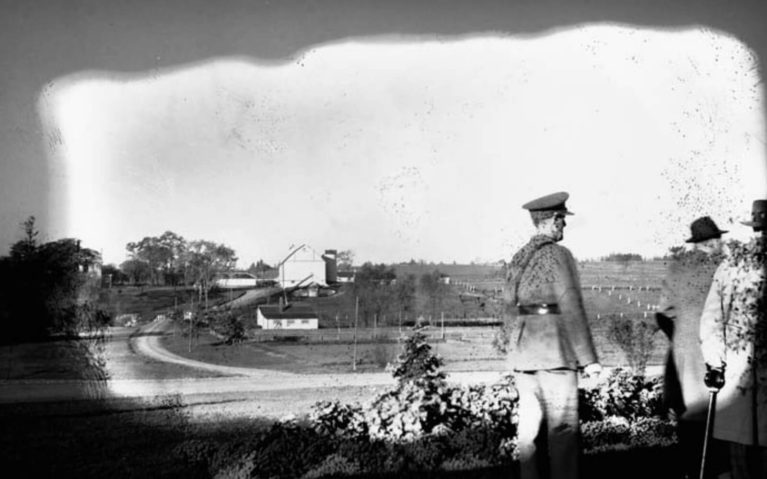
Old photo of the Bowmanville POW Camp. Taken from the Clarington website.
Visiting the Jury Lands
Often referred to as the Jury Lands in reference to John H. H. Jury, visiting the Bowmanville POW Camp is actually quite easy if you know where you’re going. When looking at Google Maps, there are two paved entrances off of Lambs Road. This is deceiving though as there is nowhere to park here, nor is parking allowed on Lambs Road itself. Your best bet is to park on Sprucewood Crescent close to Madden Place. This is the entrance to the Ehrenwort Trail which will lead you to Camp 30. The trail runs through the grounds south towards Concession Street East. You could also enter via Concession Street East however I don’t believe there is parking available.
The property is eerily quiet with a sense of foreboding. I’ve read that many have said the spiritual energy is strong at Camp 30 and I believe it. Maybe it’s just me, but I felt more and more uneasy as I got closer to the camp. It didn’t help that I heard a random jingling almost like a set of keys while exploring. Lindsay, it was probably a chain of some sort on a fence or something. I thought that too but didn’t see anything in sight… nor anything close enough to make the sound. Maybe it was my overactive imagination but consider me spooked!
You’ll quickly notice that there are satellite security cameras located throughout the property. These were installed to deter any further vandalism at the site as a few of the original buildings have since been torn down due to fire damage rendering them unstable. These cameras have motion sensors and are monitored by a security company 24 hours a day, 7 days a week. If any foul play is suspected, the local police department is dispatched immediately.
If this makes you nervous to explore, don’t be. I felt the same way – so much that I even called the municipality of Clarington where Bowmanville is located for more information. I’m a chicken sh!t and don’t like getting in trouble, okay? When exploring, just stay on the paved oval road and it will allow you to see all of the buildings without any repercussions. Venture off at your own risk. While it would be nice to get a closer view, don’t be the one that makes headlines by being arrested. If curiosity is getting to you, here’s an in-depth video from 2013 that documents inside the buildings by an urban explorer.
PUBLIC SERVICE ANNOUNCEMENT: Seriously though, don’t be an idiot. Not only is this site an important piece of history for the area as well as the province and country, it’s still private property. Respect it and you shouldn’t run into any trouble. I legit showed up in a toque and hoodie with camera in hand and didn’t have any problems. If there is a security guard and they ask you to leave, then do so. This area is to be respected and if you have any concerns at all, contact the Municipality of Clarington.
Guided Tours Along the Ehrenwort Trail
Over the past few years, guided tours of Camp 30 have been given to raise more awareness about this piece of history. Tours are organized by the Jury Lands Foundation, a not-for-profit organization that is looking to rejuvenate this historically significant site. They occur at least once a month and each one is 90 minutes long. In 2018, there were 10 tours from May until September. However if you’ve just missed them like I did, you can take a self-guided tour along the Ehrenwort Trail.
NOTE: As of right now, tours for 2022 are running until October 10th but the schedule is subject to change. Keep an eye on the Jury Lands website for full details.
As I mentioned earlier, park on Sprucewood Crescent as this is where the Ehrenwort Trail begins. Follow the gravel path and you’ll first reach the dam. As the Bowmanville Boys Training School was conceived as a self-sufficient site, farming was part of the training boys received and they assisted with producing food for the school. This dam helped generate power for the site. Cross it and in just a few metres you’ll arrive at the Camp 30 site.
You’ll arrive at the west side of the oval loop which takes you through the campus. On your left, you’ll see the Jury Lodge, named after John H. H. Jury though I’m unsure as to how the building was used. Close by you’ll also see the pool and gymnasium buildings. Referred to as the Natatorium, it would have been one of, if not the first indoor pool in Canada. It was used by not just the boys but the Bowmanville community. Next is House IV, also known as the triple dorm. This is where prisoners attempted to escape by digging tunnels under the building. Continue along and you’ll see the Infirmary/General’s House where three German Generals were housed as well as the Kiwanis House which supported the Bowmanville Boys Training School by sponsoring this dormitory. The largest of the buildings is the cafeteria which was built to accommodate 300 students. When it became Camp 30, each meal had at least two sittings to accommodate the prisoner numbers. This is where the Battle of Bowmanville occurred.
The campus is not complete however as fires engulfed the Administration building. To see the full tour, check out this historical tour pamphlet which outlines the trail.
SOMETHING TO NOTE: Since I did this self-guided, I may have mislabelled a few of the buildings. I have done my best to figure out which building is which based on my powers of deduction. If I’ve made a mistake, please let me know so I can correct it!
Future of the Jury Lands
At one point the future of the Bowmanville POW Camp was bleak. It was even listed on Heritage Canada’s Top 10 Endangered Places in 2013. While it was set to be demolished to make way for a housing development, in receiving historic status that has since changed. The six major buildings were designated under the Ontario Heritage Act in January of 2018 and they have become the cornerstone for future plans.
Future development of the Jury Lands is looking to repurpose those six buildings as well as the space along Soper Creek. Possibilities for a daycare, fitness centre, office space and even the possibility of a boutique hotel. Additionally, ideas for a park, restaurant, Soper Creek lookout and outdoor event space have been tabled.
Residential complexes would reside on either side of Camp 30. Both of these and the Bowmanville POW Camp would be connected for use by everyone in the community. It would be great to see this area with a dark past transformed into a helpful, positive space. A full analysis and plan has been drafted and can be viewed here.
Final Thoughts
Despite the fact my heart was pounding in my chest, I’m so glad I went to experience it. If you plan a trip, I can’t stress enough to respect the area. It’s a privilege to experience, not a playground for visitors to run rampant. Also, it’s seriously creepy. Maybe I’m just a scaredy cat but I only spent about half an hour and that was enough for me. Maybe it would be less eerie without the ominous clouds and a less spooky time of year…
It’s important to preserve the history of Canada, dark or otherwise. The Bowmanville POW Camp has a rich history that is on its way to being preserved. While it has a long journey ahead that’s in the beginning stages, more awareness and understanding of this area can see it remembered for days to come. With that, it’s important to note that the German prisoners at Camp 30 were some of the more fortunate and many atrocities happened within the POW camps of World War II.
If you do choose to visit Camp 30, please do so respectfully. Not only respect the land but also respect the memories of those from the Second World War. So many people tragically lost their lives from 1941-1945 and we need to remember this. It’s easy to be caught up in the present state of affairs, but never forget where you came from.
If you’re looking for more things to do in the area…
Check Out These Amazing Things to Do in Clarington
Planning to visit Camp 30: the Bowmanville POW Camp? Pin it for later.

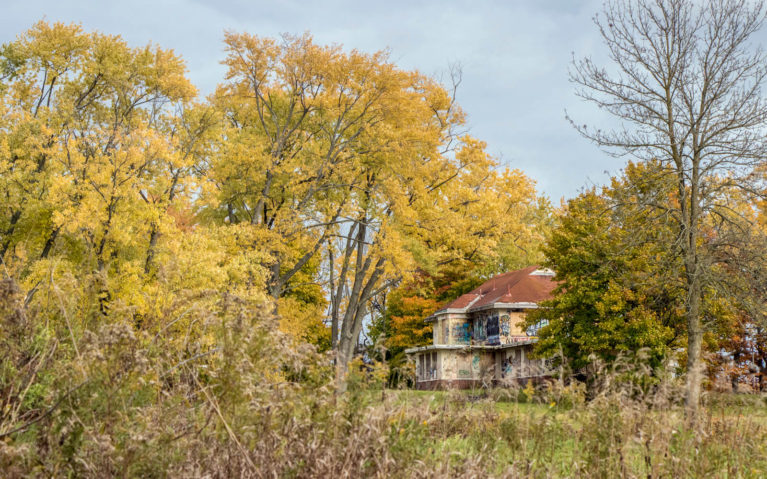
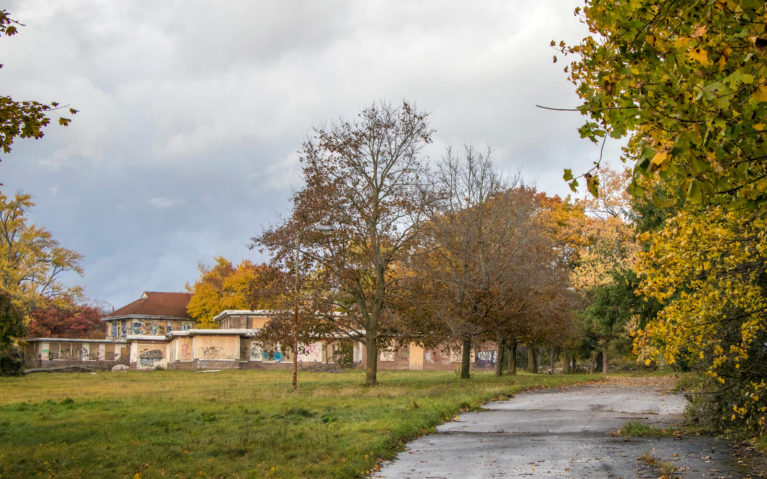
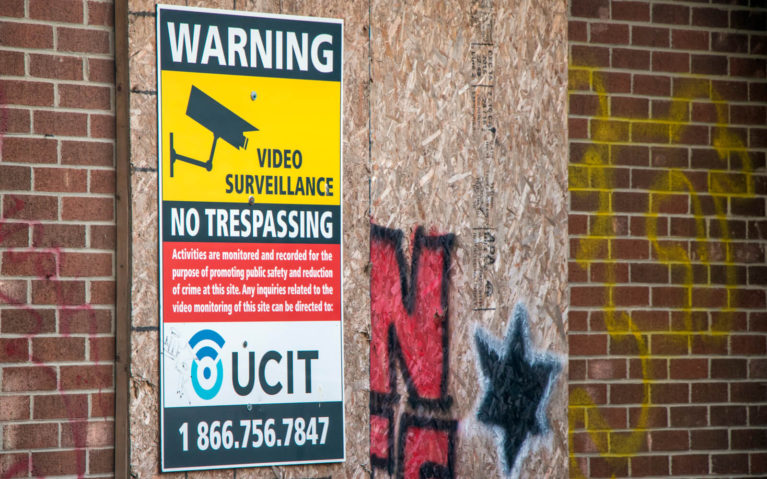
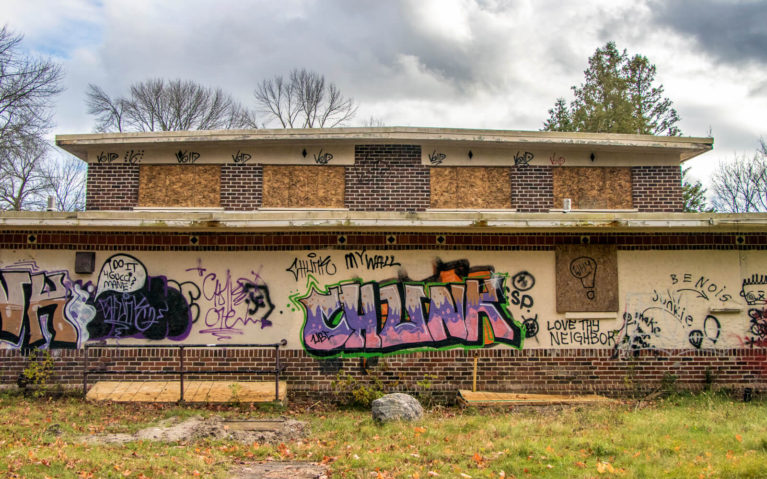
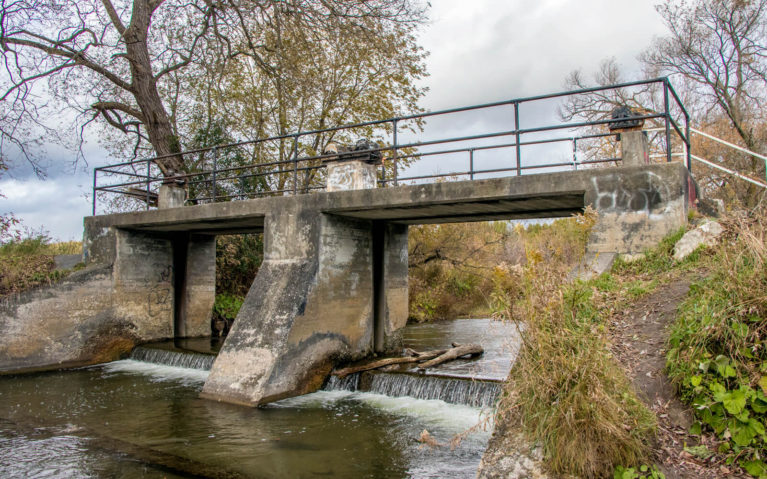
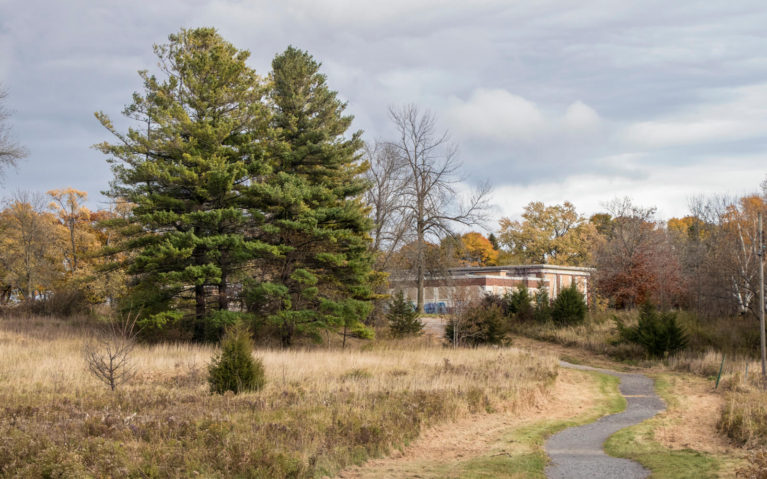
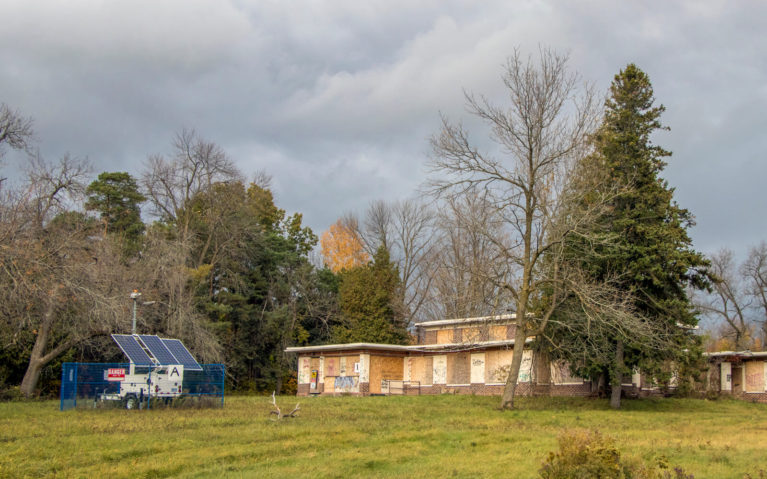
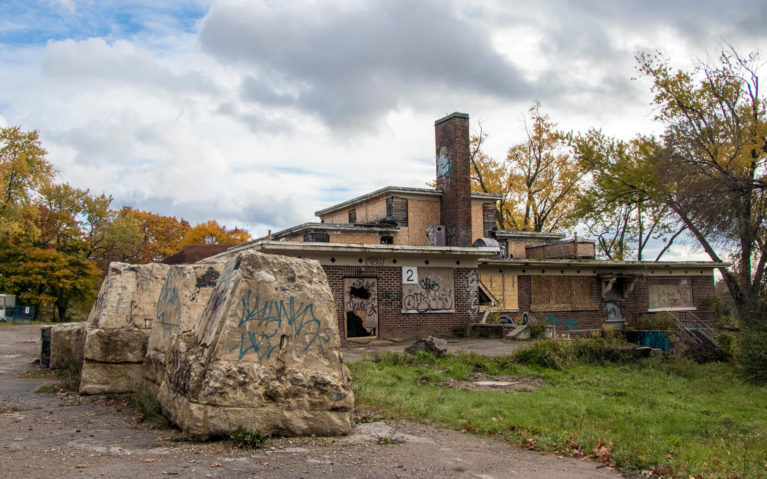

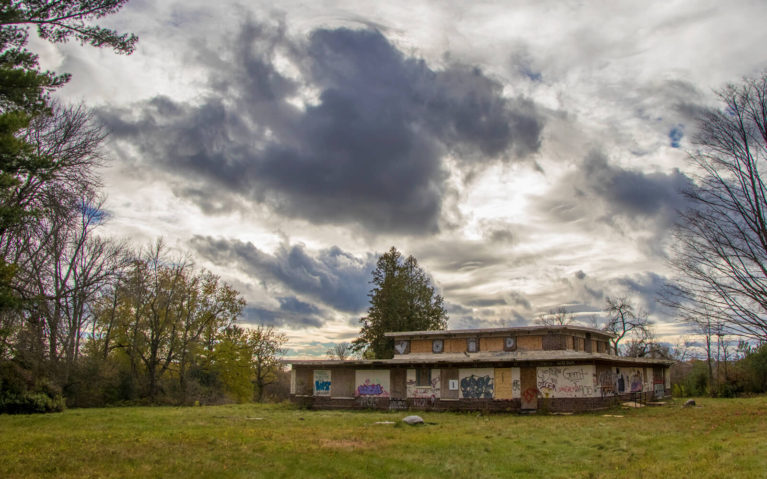

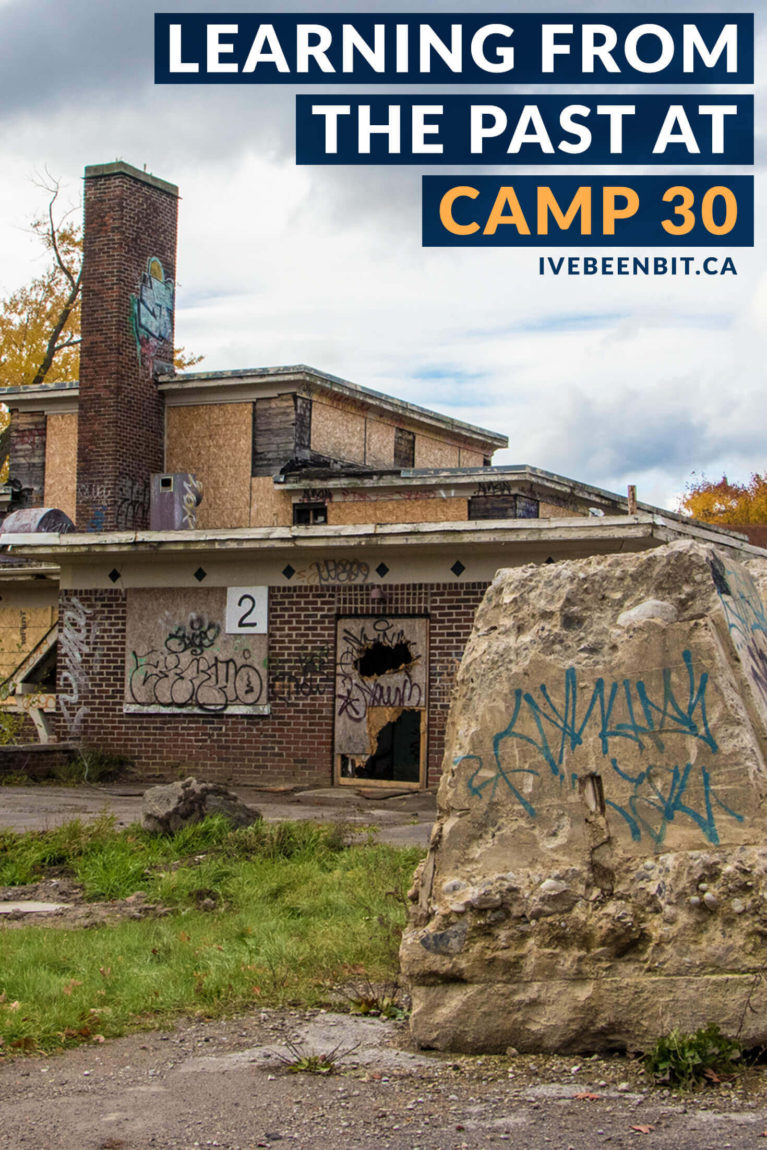











Lise
Thank you Lindsay, as a fellow Canadian from Quebec, it’s really interesting to learn about this history. 🙂
Lindz author
I’m so happy to hear that Lise! One of the reasons I love travel blogging is I discover and learn about places like this. I’m glad you could learn from my post 🙂 Thank you for your comment!
Clazz
Wooooahh! I love places like this, and the history is always so interesting too. Thanks for sharing it, it would be such a shame if it got demolished.
Lindz author
I don’t think it’ll be demolished but rather repurposed! Time will tell but I’m curious to know what will become of the site.
Nafisa Habib
I learned something new through your post. Definitely, it’s a huge privilege to experience. Loving every shot!
Lindz author
Thanks for the comment! It truly is a privilege and I hope others realize that too!
Beth
I’m from Peterborough, and have been here twice. The last time was in 2012. You are so right about the eerie/creepy feeling that this place gives off. The last time I was there I was with my dog, and he would not stop barking at one of the houses. Made the feeling 10x worse. Definitely some odd energy. I’m so happy to read that there is a plan in place to restore the site, and that it isn’t being knocked down.
Kathryn Dickson
Call me next time you go exploring to these places! I love this stuff!
Lindz author
Haha it was a spur of the moment decision to visit but noted!
Kayla Watson
Incredible! I had no idea Canada had a historic site such of this. We’ve been visiting all the WW2 sites around SE Asia. Will definitely need to visit this when I am home in Canada! I’m also a chicken haha, my partner is the brave one when we visit things like this!
Lindz author
Haha glad to hear I’m not the only chicken! There are quite a few in Ontario which really surprised me but I really learned so much while researching this post. Visiting just showed me how important it is to remember and respect places like Camp 30.
Dagney
This was truly fascinating. POW camps are something I am aware exist, but know very little about (outside of the basics they were used for). I also didn’t realise there were so many POW camps in Canada, although I did know some were about. Although sadly it doesn’t surprise me. I definitely would like to visit one, though, and for the time being I got to do that through this lovely post. Thanks for highlighting the importance of respecting historical sites like this. It drives me crazy when people just do whatever they want at historical or religious/sacred sites because they don’t seem to think the rules apply to them!
Lindz author
I had no idea about the POW camps here in Canada before this too. I thought it was more in Europe but clearly I was naive! Thank you for commenting, and I always do my best to highlight how much we need to respect places like this. Too many times it seems people think we’re “entitled” to visit but rather it’s very much a privilege and I’m glad you agree 🙂
Olivia
NOPE NOPE NOPE. Hard pass. This is how horror movies start!! HAHAHAHA. I would be way too nervous about being attacked by a ghost then arrested to go here. (I love your warning “Don’t be an idiot”). I’m happy you found a tiny waterfall too! It wouldn’t be a Lindsay trip if you didn’t 😀
Lindz author
BAHAHA it’s so true! If anyone is gonna find a waterfall it’s this girl 😹 And oh man I swear that key jingle was definitely from a spirit and I sure got out real quick!
April
Wow, that is so fascinating. I had no idea that Canada had POW camps. Thank you for the great history lesson. Definitely a place I’d love to visit when I’m in the area. Thanks for sharing.
Lindz author
I’m so glad I can share this with others! It seems a lot of people don’t realize we have sites like this in Canada and I’m happy I can change that 🙂
Josy A
Woah. I had no idea that the UK sent POWs to Canada during the war. This was really really interesting, so tank you for sharing. It must be strange to go around this kind of historical site when it’s all boarded up!
I love that you called the municipality of Clarington, to make sure you wouldn’t be arrested. I’d want to do that too, just to make sure. 😉
Meggan
Wow, I had literally no idea we had POW camps in Canada and the Bowmanville POW Camp sounds fascinating. Sounds like because of it being a boy school that life there wasn’t so bad but of course, they were still POWs. I really like how you urge people to be respectful and I am happy to hear they are looking to re-purpose it as well! I learned something new today – thanks! 🙂
Lindz author
I’m happy to hear this! One of the things I love about blogging is that I can not only learn myself but I can each others about places like this and their history 🙂
Doreen Pendgracs
I had no idea there were 26 POW camps in Canada and had never heard of Bowmanville. Thx for the fascinating post.
Sue
I just came across this information about the POW camp. I was born in Bowmanville in 1950 and when my father purchased land to build our house, I was told that he had purchased a structure which I’m thinking may have come from the camp and had it moved to the property where he added to it for our house. Since both my parents are no longer alive, I was wondering if you know anything about this. I actually was told that this may have happened from the museum in Bowmanville that we visited about 3 years ago.
Lindz author
Hmm that’s a great question Sue! I’d say get in contact with the Jury Lands Foundation – they might be able to offer more help 🙂 https://jurylandsfoundation.com/
Victor Suppan
Hi there Sue and Lindz, came across this website and would like to inform you that many of the material from the internment camp was sold in 1946 by the Toronto Construction Company. The materials were used to build a number of homes on Veterans Avenue, second Avenue and Lambs Lane. We are trying to determine which homes contain these materials and would appreciate any leads that may come my way. Oh by the way, I have been on the municipal heritage committee for the last 25 years.
I am glad about your concern for the local heritage of Clarington.
Thanks
Harold Clifford
The “dark side” of this historical site is much deeper than the public has been led to believe. To anyone contemplating this dark history tour, then be aware of it’s history post WWII. As a 13 year old boy and former resident of Bowmanville Training School from 1977-1979 (yes that’s right the government returned this property to it’s former use as a boys reformatory after the war in 1945) when the school was closed by the Provincial Government due to the systemic abuses to children from government employees who worked and played there. These government paid child abusers and pedophiles have been being exposed long before the closure of 1979 and have continued since. I will be participating this year 2020 in the Class Action Lawsuit against the Provincial Government for their failure of Duty of Care to Children during the time of incarceration of all children who resided there between January 1, 1953 and it’s closure in 1979.The Class Suit can be found at kmlaw.ca/cases/ontario-training-schools/. The Provincial Government knowingly will now be held accountable for the suffering they have caused to thousands of children. After reviewing many Camp 30 google posts I feel overwhelmingly incumbent to bring these facts to the public since the public has no knowledge of the history at Camp 30 after the war. God bless to all who passed through this horrible place as a child!
Lindz author
Wow, I honestly have no words other than to say thank you for your bravery in sharing this and your story.
Cheryl
Hi Sue I found your story quite interesting. I myself grew up in Bowmanville and our house came from the POW Camp. My parents purchased their home in 1956. My mother still resides in this home. Upon speaking with my mother she believes you may be the daughter of the original owners as their one daughters name she believes was Sue. Would your parents names possibly have been Leo and Pat? Feel free to contact me if you believe this may have been your parents home.
Jim Finn
Great historical place to explore however the Police aren’t keen on anyone being there, $65 fine for everyone in your group caught there….found out the hard way.
Lindz author
That’s very unfortunate to hear, Jim! Were you off the paved path at all? I was told that security and the police are very strict about this but I can definitely look into it more with the local tourism board.
SSHS Alum
Interesting fact and recent history no one really talks about… In the 90s it was the site of St Stephen’s Catholic Secondary school.
School board was looking for land to build a new high school in Bowmanville. While they were searching the school board rented from another religious organization who owned the land (Micas or Micahs)
There’s a small group of people who experienced HS life at a place that was like a mini University campus or one of those New England style private schools.
No barbed wire or guard towers. Just a portapack that was added to existing buildings and then more portables as the school grew from 200 students to 600+ in 8 years.
Lindz author
Interesting! I see that St Stephen’s Catholic Secondary School now exists on Scugog Street. I’d be curious to know more about why the move. Thank you for sharing!
Daniel von Richthofen
Hello Lindz,
Thank you for this very well written and informative article on a little known piece of history. I came across your site after reading a review of a maritime book called “Otto Kretschmer: The life of the Third Reich’s Highest Scoring U-Boat Commander” by Lawrence Patterson, Greenhill Books, ISBN 978-1-78438-192-9. Kretschmer was responsible for sinking 47 ships from various U boats, and was known as “Silent Otto” for maintaining radio silence in defiance of his HQ. After the loss of his last boat, U99, he was captured and sent to Bowmanville. Not all must have been quite as innocent as it seems. The book review notes that Kretschmer “organized a 2-way radio link to the German Naval High Command and planned a mass breakout with a U-boat rendezvous arranged. He was also instrumental in the “Battle of Bowmanville” which lasted for three days in October 1942.”
This citation is from “Marine News”, World Ship Society, July 2018, p442.
Sad that the camp went on to become another tragic chapter in residential school history. That might make it even creepier!
Thank you again for a well presented and illustrated story.
Daniel v. R.
Lindz author
Thank you so much for your comment Daniel! I’m glad you found my article informative. It’s so important that we preserve relics like this from the past so that we may learn from them as we shape the future. Be well! 🙂
Elly
I was a student here when it was an international school in the late 1980s. Curious to know what will become of this place. I had a scary experience when I first arrived at the school!
Lindz author
Oh wow, that must have been quite the experience, Elly! I’m curious to know as well – I know there are talks to develop it in such a way that it will be helpful to the community with various amenities while preserving the historical aspects of it… but time will tell!
Trish
Grew up near this place. I can remember going there for swimming and water polo in the late 70’s. Im glad that it will be preserved.
Don
I recently moved to Bowmanville after being away for a while, and have been walking my dog up in this location. I wanted to find more of the story of it and you did just that! I would like to thank you for all your hard work and the beautiful pictures from archives tell the story, like you said whether good or bad. From one of your links I reached out to the jury boards and found out that they did produce their own Hydro and sewage system separate from Bowmanville. I have been Enjoying sharing this to my siblings who went to the old high school there at St Stephens and they felt it was like a college campus and loved it. I have shared it with my parents who remember it back in the day and also are watching to see how it is developed.
Who would’ve thought all your expiration would trigger and bring out so many wonderful memories? Excellent job all around.
Lindz author
Oh Don, comments like this are what keep me going! You’ve filled my heart with such joy and I’m so happy you enjoyed the article. That’s incredible about the separate hydro and sewage system – I had no idea! You’re teaching me now! 🙂 Thank you so much for taking the time to leave a comment. You just made my day!
Dolphin
Lindz, great work and thanks so much for sharing the rich history about Camp30. Almost 20 years ago, I spent 6 month there as a member of an international/private/boarding school. Lived both in the “Infirmary” and “Kiwanis House”, your post brought back so many memories! It’s sad to see all the vandalism but such an interesting way to spent Canada Day! Thank you so much.
Ken
A very interesting article, with sad comments about child abuse in it’s later use.
I thought there was a rumour that one of the staff members during the Camp 30 days became known for his book writing afterwards. I thought it was Ian Fleming but his biography on Wikipedia does not mention it. Do you have any research to suggest that the rumour was factual?
Thanks for your article.
Julie
Thanks for a great article, Lindsay. I just finished reading a novel called Bowmanville Break by Sidney Shelley. It’s a fictionalized account of the “battle of Bowmanville” and Operation Kiebitz that was written in 1968. I was curious about how much of it was fiction, and your article fills in a lot of the details.
Lindz author
Thank you so much for your kind words, Julie! That sounds like a fascinating novel and I’m certainly curious now to know how much is fiction and how much is true to history! I’m glad my article could help fill in some gaps for you 🙂
Keith
to the Harold Clifford story I was also sent to bowmaville training school at 13yrs.old in 1972,73,74.was run like a military camp,that employed a bunch of power hungry so called adults that beat kids daily or had other kids gang up on other kids and the Ontario gov. done nothing about it .Class action still waiting for the goverment to get with the lawyers as of june 27/23. the comment asked about jury lodge was called jury house which housed kids.The triple building was north,rotary,and south house which also housed kids. thanks Harold